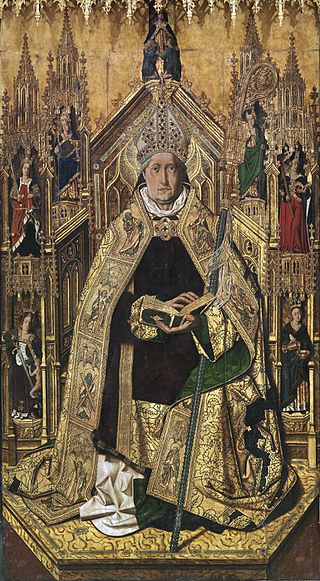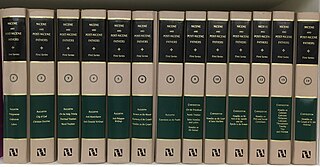
Abbot is an ecclesiastical title given to the head of an independent monastery for men in various Western Christian traditions. The name is derived from abba, the Syriac form of the Hebrew ab, and means "father". The female equivalent is abbess.

Benedict of Nursia, often known as Saint Benedict, was an Italian Christian monk, writer, and theologian. He is venerated in the Catholic Church, the Eastern Orthodox Church, the Oriental Orthodox Churches, the Anglican Communion, and Old Catholic Churches. In 1964 Pope Paul VI declared Benedict a patron saint of Europe.

Bede, also known as Saint Bede, The Venerable Bede, and Bede the Venerable, was an English monk and an author and scholar. He was one of the greatest teachers and writers during the Early Middle Ages, and his most famous work, Ecclesiastical History of the English People, gained him the title "The Father of English History". He served at the monastery of St Peter and its companion monastery of St Paul in the Kingdom of Northumbria of the Angles.

Columbanus was an Irish missionary notable for founding a number of monasteries after 590 in the Frankish and Lombard kingdoms, most notably Luxeuil Abbey in present-day France and Bobbio Abbey in present-day Italy.

A Select Library of the Nicene and Post-Nicene Fathers of the Christian Church, usually known as the Nicene and Post-Nicene Fathers (NPNF), is a set of books containing translations of early Christian writings into English. It was published between 1886 and 1900.

Aldhelm, Abbot of Malmesbury Abbey, Bishop of Sherborne, and a writer and scholar of Latin poetry, was born before the middle of the 7th century. He is said to have been the son of Kenten, who was of the royal house of Wessex. He was certainly not, as his early biographer Faritius asserts, the brother of King Ine. After his death he was venerated as a saint, his feast day being the day of his death, 25 May.

Christian monasticism is the devotional practice of Christians who live ascetic and typically cloistered lives that are dedicated to Christian worship. It began to develop early in the history of the Christian Church, modeled upon scriptural examples and ideals, including those in the Old Testament. It has come to be regulated by religious rules and, in modern times, the Canon law of the respective Christian denominations that have forms of monastic living. Those living the monastic life are known by the generic terms monks (men) and nuns (women). The word monk originated from the Greek μοναχός, itself from μόνος meaning 'alone'.

Honoratus was the founder of Lérins Abbey who later became an early Archbishop of Arles. He is honored as a saint in the Catholic and Eastern Orthodox Churches.

Caesarius of Arles, sometimes called "of Chalon" from his birthplace Chalon-sur-Saône, was the foremost ecclesiastic of his generation in Merovingian Gaul. Caesarius is considered to be of the last generation of church leaders of Gaul who worked to integrate large-scale ascetic elements into the Western Christian tradition. William E. Klingshirn's study of Caesarius depicts Caesarius as having the reputation of a "popular preacher of great fervour and enduring influence". Among those who exercised the greatest influence on Caesarius were Augustine of Hippo, Julianus Pomerius, and John Cassian.

The Rule of Saint Augustine, written in about the year 400, is a brief document divided into eight chapters and serves as an outline for religious life lived in community. It is the oldest monastic rule in the Western Church.

John Cassian, also known as John the Ascetic and John Cassian the Roman, was a Christian monk and theologian celebrated in both the Western and Eastern churches for his mystical writings. Cassian is noted for his role in bringing the ideas and practices of early Christian monasticism to the medieval West.

Lérins Abbey is a Cistercian monastery on the island of Saint-Honorat, one of the Lérins Islands, on the French Riviera, with an active monastic community.

Isidore of Pelusium was born in Egypt to a prominent Alexandrian family. He became an ascetic, and moved to a mountain near the city of Pelusium, in the tradition of the Desert Fathers.

Fructuosus of Braga, was the Bishop of Dumio and Archbishop of Braga, also known for being a great founder of monasteries The son of a Visigothic dux in the region of Bierzo, at a young age he accompanied his father on official trips over his estates. After a period spent as a hermit, he established a monastery at Complutum and became its first abbot.

The Abbey of Saint-Victor is a former abbey that was founded during the late Roman period in Marseille in the south of France, named after the local soldier saint and martyr, Victor of Marseilles.
There is archaeological evidence of insular monasticism as early as the mid 5th century, influenced by establishments in Gaul such as the monastery of Martin of Tours at Marmoutier, the abbey established by Honoratus at Lérins; the abbey of Mont-Saint-Michel; and that of Germanus at Auxerre. Many Irish monks studied at Candida Casa near Whithorn in what is now Galloway in Scotland.

Eastern Christian monasticism is the life followed by monks and nuns of the Eastern Orthodox Church, Oriental Orthodoxy, the Church of the East and Eastern Catholicism. Eastern monasticism is founded on the Rule of St Basil and is sometimes thus referred to as Basilian.
Gaul was an important early center of Latin Christianity during late antiquity and the Merovingian period. By the middle of the 3rd century, there were several churches organized in Roman Gaul, and soon after the cessation of persecution, the bishops of the Latin world assembled at Arles, in AD 314. The Church of Gaul passed through three crises in the late Roman period, Arianism, Priscillianism and Pelagianism. Under Merovingian rule, a number of "Frankish synods" were held, marking a particularly Germanic development in the Western Church. A model for the following Frankish synods was set by Clovis I, who organized the First Council of Orléans (511).
"A religious institute is a society in which members, according to proper law, pronounce public vows, either perpetual or temporary which are to be renewed, however, when the period of time has elapsed, and lead a life of brothers or sisters in common."

Peter Damian, OSB was an Italian reforming Benedictine monk and cardinal in the circle of Pope Leo IX. Dante placed him in one of the highest circles of Paradiso as a great predecessor of Francis of Assisi and he was declared a Doctor of the Church on 27 September 1828. His feast day is 21 February.















